
We are excited to announce that we now have a honey bee hive that houses Italian honey bees! We have cultural diversity everywhere here at FOA even in our honey bees! Our hive of Italian honeybees (Apis mellifera) includes approximately 10,000 bees, including nurse bees, forager bees, guard bees, drone bees, and a newly mated queen bee. Our hive is located on the nature trail next to the stream and will be available for observation to our students. Bees are so fascinating and essential for our existence. We know this will spur a lot of new research and interest among our students.
Once the bees establish themselves and draw out new honeycomb, the queen will start laying eggs. The first bees will hatch in 21 days. Up to 2,000 bees per day could hatch during peak foraging. New supers will be added as the colony size grows. The hive may have as many as 60,000 bees by midsummer. If the current hive is growing well, it can be split to start a new hive.

We also have a blog dedicated to our Italian honeybees where you can read about the exciting developments in our hive and also subscribe to it if you’d like. We are so grateful for our beekeeper/ FOA parent, Dan Magner, for overseeing this amazing project and being a mentor to our students. Several of the Upper Elementary students have taken a special interest in learning about these extraordinary creatures and how to care for them. These junior beekeepers got to experience a hive check and even taste a tiny bit of the sweet honey our bees have made. To keep up with what is happening in our hive, go to https://hivehappenings.wordpress.com/.
Interesting facts and safety information to share with your child:
- This species produces more honey than it consumes and this will allow us to collect honey from them. An established hive will produce up to 60 lbs (5 gallons) of honey per year. Generally, not as much or sometimes no honey is collected during the first year because the bees are using much of it to build new wax honeycombs. Bees must consume 6-8 pounds of honey to produce 1 pound of wax.
• Will honeybees sting? Honeybees are very gentle creatures! You could stand at the front entrance of their hive all day and they wouldn’t bother you. Honeybees really don’t want to sting you. That being said, they will sting if they feel you are threatening their eggs or their honey, and you don’t back off after ample warning. In other words, you are most likely to be stung when the hive is open.
• How can I tell if the bees are feeling threatened? They will give you plenty of warning that is pretty easy to figure out. Some bees will come out of the hive and bump into you repeatedly as a way to say, “back off a little bit.” If
the person is being bumped naturally takes a few steps back, it’s usually enough to satisfy the bees. If that doesn’t work, they give off an alarm pheromone that smells just like bananas! It’s really quite amazing! - Why do you need a bee suit and smoke when opening the hives for inspection or to collect honey? Bees feel threatened when their hive is opened. Smoke is used primarily for two reasons: it masks their alarm pheromone so they can’t signal other bees; and it simulates a nearby fire, which encourages the bees to start eating honey in lieu of all else in case they need to depart in a hurry. Since the bees are so busy doing other things, smoke makes it easy to check the hives. The bee suit is an extra precaution, but really all that is needed is a veil.


